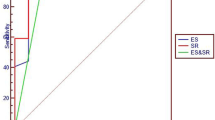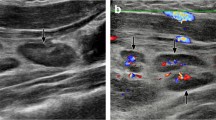Abstract
Purpose
Controversy exists as regards the best non-invasive diagnostic tool for pediatric cervical lymphadenopathy. The current work aimed to evaluate the reliability, sensitivity, specificity, and accuracy of sonoelastography in diagnosing benign and/or malignant pediatric cervical lymphadenopathy.
Methods
Prospective study took place over a period of 4 years from January 2013 to December 2016. A total of 177 lymph nodes (LNs) in 128 children with an age ranging from 11 months to 12 years were recruited in this study. Patients were 77 males and 51 females with a ratio of 3:2. All patients underwent a thorough history taking and clinical examination of the neck focusing on the cervical lymph nodes. After that, a B-mode sonography, Color Doppler ultrasound, and Sonoelastography were performed. Elastographic patterns of 1–5 were evaluated, whereas patterns of 3–5 (firm to hard) were suspected to have a malignant nature. Sonographic-guided aspiration cytology took place in 107 lymph nodes and excisional biopsy in 102 lymph nodes, whereas 13 lymph nodes responded adequately to conservative treatment. They proved to be benign reactive hyperplasia.
Results
The majority of LNs (87%) were of the malignant type that showed an elastographic pattern of 3–5. The same patterns were observed in only 6 (3.4%) of the benign LNs. Sonoelastography showed a sensitivity of 85.9%, specificity of 100%, PPV of 100%, NPV of 75.96%, and overall accuracy of 90.23% in distinguishing benign from malignant lymph nodes. Using the B-Mode ultrasound, an abnormal hilum was seen in 75%. The accuracy of color Doppler US reached 82.7%.
Conclusions
Sonoelastography may be superior to other US modalities in elucidating different cervical lymph node biopsy helping to distinguish benign from malignant lesions. This may replace the lymph node biopsies in the future. Moreover, its use in the follow-up of patients with cervical malignancies may reduce the number of future biopsies. Further studies with more patients may be needed for a better assessment of results.


Similar content being viewed by others
References
Hefeda MM, Badawy ME (2014) Can ultrasound elastography distinguish metastatic from reactive lymph nodes in patients with primary head and neck cancers? EJRNM 45:715–722
Ahuja A, Ying M (2002) An overview of neck node sonography. Invest Radiol 37:333–342
Torsiglieri AJ, Tom LW, Ross AJ, Wetmore RF, Handler SD, Potsic WP (1988) Pediatric neck masses: guidelines for evaulation. Int J Pediatr Otorhinolaryngol 16:199–210
Lerner RM, Huang SR, Parker KJ (1990) “Sonoelasticity” images derived from ultrasound signals in mechanically vibrated tissues. Ultrasound Med Biol 16:231–239
Bhargava S, Bhargava SK, Sharma S, Prakash M (2013) Elastography: a new imaging technique and its application. JIMSA 26:25–30
Chiorean L, Barr RG, Braden B, Jenssen C, Cui XW, Hocke M, Schuler A, Dietrich CF (2016) Transcutaneous ultrasound: elastographic lymph node evaluation. Current clinical applications and literature review. Ultrasound Med Biol 42:16–30
Glaser KJ, Felmlee JP, Manduca A, Kannan Mariappan Y, Ehman RL (2006) Stiffness-weighted magnetic resonance imaging. Magn Reson Med 55:59–67
Huwart L, Peeters F, Sinkus R, Annet L, Salameh N, ter Beek LC, Horsmans Y, Van Beers BE (2006) Liver fibrosis: non-invasive assessment with MR elastography. NMR Biomed 19:173–179
Dudea S, Botar-Jid C, Dumitriu D, Vasilescu D, Manole S, Lenghel M (2013) Differentiating benign from malignant superficial lymph nodes with sonoelastography. Med Ultrason 15:132–139
Teng DK, Wang H, Lin YQ, Sui GQ, Guo F, Sun LN (2012) Value of ultrasound elastography in assessment of enlarged cervical lymph nodes. Asian Pac J Cancer Prev 13:2081–2085
Hasan DI, Ahmed AF, Haggag R, Mohamed A (2016) Ultrasound elastography in pathological enlarged cervical lymph nodes compared to histopathology. EJRNM 47:1349–1359
Lo WC, Cheng PW, Wang CT, Liao LJ (2013) Real-time ultrasound elastography: as assessment of enlarged cervical lymph nodes. Eur Radiol 23:2351–2357
Dudea SM, Lenghel M, Botar-Jid C, Vasilescu D, Duma M (2012) Ultrasonography of superficial lymphnodes: benign vs. malignant. Med Ultrason 14:294–306
Alam F, Naito K, Horiguchi J, Fukuda H, Tachikake T, Ito K (2008) Accuracy of sonographic elastography in the differential diagnosis of enlarged cervical lymph nodes: comparison with conventional B-mode sonography. Am J Roenttgenol 191:604–610
Lee DH, Baek HJ, Kook H, Yoon TM, Lee JK (2014) Clinical value of fine needle aspiration cytology in pediatric cervical lymphadenopathy patients under 12-years-of-age. Int J Pediatr Otorhinolaryngol 78:79–81
Kurt A, Gunes Tatar I, Ipek A, Hekimoglu B (2013) B mode and elastosonographic evaluation to determine the reference elastosonography values for cervical lymph nodes. ISRN Radiol. https://doi.org/10.5402/2013/895287
Arda K, Ciledag N, Gumusdag PD (2010) Differential diagnosis of malignant cervical lymph nodes at real-time ultrasonographic elastography and Doppler ultrasonography. Magy Radiol Online 6:10–13
Imani Moghaddam M, Davachi B, Mostaan LV, Langaroodi AJ, Memar B, Azimi SA, Marouzi P (2011) Evaluation of the sonographic features of metastatic cervical lymph nodes in patients with head and neck malignancy. J Craniofac Surg 22:2179–2184
Sakaguchi T, Yamashita Y, Katahira K, Nishimura R, Baba Y, Arakawa A, Takahashi M, Yumoto E, Shinohara M (2001) Differential diagnosis of small round cervical lymph nodes: comparison of power Doppler US with contrast-enhanced CT and pathologic results. Radiat Med 19:119–125
Sumi M, Ohki M, Nakamura T (2001) Comparison of sonography and CT for differentiating benign from malignant cervical lymph nodes in patients with squamous cell carcinoma of the head and neck. Am J Roentgenol 176:1019–1024
Dangore-Khasbage S, Degwekar SS, Bhowate RR, Banode PJ, Bhake A, Choudhary MS, Lohe VK (2009) Utility of color Doppler ultrasound in evaluating the status of cervical lymph nodes in oral cancer. Oral Surg Oral Med Oral Pathol Oral Radiol Enodod 108:255–263
Raja Lakshmi C, Sudhakara Rao M, Ravikiran A, Sathish S, Bhavana SM (2014) Evaluation of reliability of ultrasonographic parameters in differentiating benign and metastatic cervical group of lymph nodes. ISRN Otolaryngol 2014:17 (Article ID 238740)
Lyshchik A, Higashi T, Asato R, Tanaka S, Ito J, Hiraoka M, Insana MF, Brill AB, Saga T, Togashi K (2007) Cervical lymph node metastases: diagnosis at sonoelastography-initial experience. Radiology 243:258–567
Ying M, Ahuja A, Brook F, Metreweli C (2001) Vascularity and grey-scale sonographic features of normal cervical lymphnodes: variations with nodal size. Clin Radiol 56:416–419
Ahuja A, Ying M (2003) Sonographic evaluation of cervical lymphadenopathy: is power Doppler sonography routinely indicated? Ultrasound Med Biol 29:353–359
Moharram MA, Abd-ElMaboud NM, Ahmed HA (2017) Evaluation of the role of sono-elastography in diagnosis of enlarged cervical lymph nodes. EJRNM 48:381–391
Funding
None.
Author information
Authors and Affiliations
Corresponding author
Ethics declarations
Conflict of interest
The authors declare that there is no conflict of interest regarding the publication of this article.
Rights and permissions
About this article
Cite this article
Zakaria, O.M., Mousa, A., AlSadhan, R. et al. Reliability of sonoelastography in predicting pediatric cervical lymph node malignancy. Pediatr Surg Int 34, 885–890 (2018). https://doi.org/10.1007/s00383-018-4301-x
Accepted:
Published:
Issue Date:
DOI: https://doi.org/10.1007/s00383-018-4301-x




